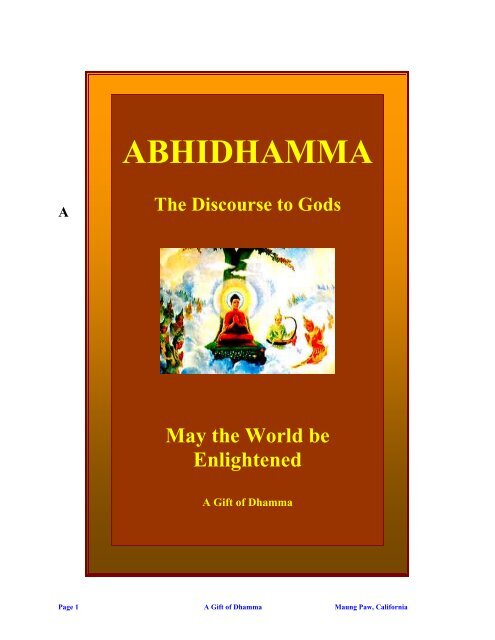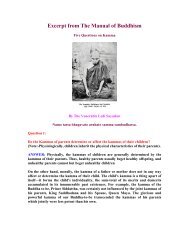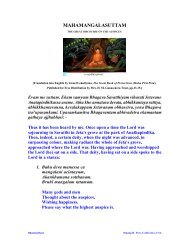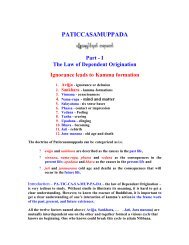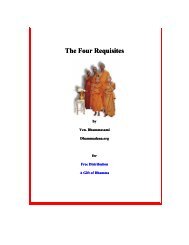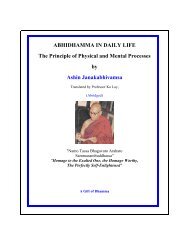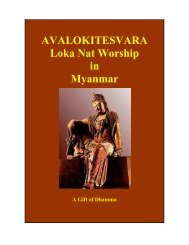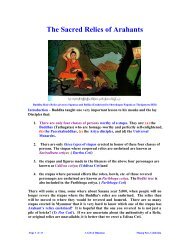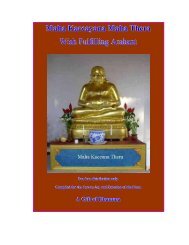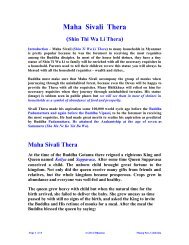You also want an ePaper? Increase the reach of your titles
YUMPU automatically turns print PDFs into web optimized ePapers that Google loves.
ABHIDHAMMAAThe Discourse to GodsMay the World beEnlightenedA Gift of DhammaPage 1 A Gift of Dhamma Maung Paw, California
The day of his return to the human world, is commemorated by Buddhists as <strong>Abhidhamma</strong> day and to emulate themiraculous scene, an annual light festival is held in all Theravada countries. In Myanmar, the light festival is knownas Thadingyut light festival. On his return to the human world, the King of the Devas, Sakka, created threestairways:1. one of gold on the right side for the devas,2. one of silver on the left side for the Brahmas and3. one in the middle of rubies for the Lord Buddha.Many deities accompanied the Lord Buddha. They held several celestial regalia.• Panca Thinkha deva on the right played the “Veluva” harp in praise of the Lord Buddha.• Matali deva on the left carried flowers and fragrance to honor the Lord Buddha.• Suyama deva carried the yak tail fly whisk,• Santussita deva held the ruby-studded gold fan and• Sakka deva blew the “Vizayuttara” Conch Shell to celebrate the occasion.All deities from the entire Universe gathered to pay homage to the Lord Buddha. The three stairways thusilluminated by the radiance from the Devas’ body lead the way to the gateway of the City of Sakassa on earth. Whenthe Lord Buddha set foot upon the earth, the crowd that awaited at the city gate all paid obeisance to the LordBuddha and a grand ceremony was held to welcome the blessed one. The Buddha with his miraculous power opensthe sight for the human to see the grandeur of the accompanying Devas and Brahmas.Thadingyut Light FestivalTo commemorate this great event in the life of the Lord Buddha, which took place on the Full moon day ofThadingyut the Myanmar hold “Tawedeintha” (Tavatimsa) festival or “Myint Mo Festival” because Tavatimsa issaid to be on the summit of Mt. Myint Mo (Mt-Meru)? In Myanmar replicas of Myint Mo are constructed torepresent the three stairways and candlelight lamps are lit in the Thadingyut festivals replicating the Lord Buddhadescend from Tavatimsa heaven to the human world on this day of Thadingyut. Many made their offerings toshrines and pagodas and alms are given to the monks. Hymns are sung in praise of the Buddha and his teaching, theDhamma.Devotional Homage –PujaThe Puja is performed by laymen to worship or making devotional offering. In Buddhism there are five infinitedebts of gratitude –1. the gratitude owed to the Buddha,2. the gratitude owed to the his teachings i.e. the Dhamma,3. the gratitude owed to the Sangha (the assembly of monks)4. the gratitude owed to the parents and5. the gratitude owed to the teachers.It is a religious obligation to worship and make devotional offerings to Buddha, Dhamma, Samghas, the parents,teachers and the elders... In addition those who are senior in age, rank, and position and those who have helped youwhile you are in difficulty should be respected, worshipped and given due puja.I will now present to you the very well written book on <strong>Abhidhamma</strong> translated by Prof. Mehm Tin Mon.Page 3 A Gift of Dhamma Maung Paw, California
BUDDHAAABHIDHAMMATHE ULTIMATE SCIENCEbYDr. Mehm Tin MonB.Sc.Hons. (Ygn), M.S., Ph.D. (U of Illinois)Professor of Chemistry (Rtd.)Professor of Samatha MeditationInternational Theravàda Buddha Missionary University, YangonAdviser to the Ministry of Religious Affairs, Union of MyanmarA Gift of DhammaPage 4 A Gift of Dhamma Maung Paw, California
6. Ghàyana-kicca – smelling the object7. Sàyana-kicca – tasting the object8. Phusana-kicca – touching the object9. Sampaticchana-kicca – receiving the object10. Santirana-kicca – investigating the object11. Votthapana-kicca – determining the object12. Javana-kicca – apperceiving or enjoying the taste of the object13. Tadàlambaõa-kicca – registering or to continue enjoying the taste of the object14. Cuti-kicca – death functionThe Cittas performing the respective FunctionsPlease refer to Chart No. 4.2 at the back for a quick view of the cittas performing their respective functions.1. There are 19 cittas which perform rebirth function. There are 2 upekkhà-santirana cittas, 8 mahà-vipàkacittas and 9 mahaggata-vipàka cittas. These cittas are known as ‘rebirth consciousness’ (patisandhi-cittas)while they perform rebirth function.2. There are 19 cittas which perform life-continuum process. They are the same as the 19 pañisandhicittas.124They are known as bhavaïga-cittas (sub-consciousness) while they perform the life-continuumprocess.3. There are 2 cittas which perform the avajjana-kicca. They are panca-dvàràvajjana citta and manodvàràvajjanacitta.4. There are 2 cittas which perform the seeing function. They are dvi-cakkhuvi¤¤àna cittas.5. There are 2 cittas which perform the hearing function. They are dvi-sotavinnàna cittas.6. There are 2 cittas which perform the smelling function. They are dvi-ghànavinnàna cittas.7. There are 2 cittas which perform the tasting function. They are dvi-jivhàvinnàna cittas.8. There are 2 cittas which perform the touching function. They are dvi-kàyavinnàna cittas.9. There are 2 cittas which perform the receiving function. They are dvi-sampañicchana cittas.10. There are 3 cittas which perform the investigation function. They are the three santirana cittas.11. There is 1 citta which performs the votthapana-kicca (determining function). It is mano-dvàràvajjana citta.12. There are 55 cittas which perform the javana-kicca. They are 12 akusala cittas, 21 kusala cittas, 4 phalanànacittas and 18 kiriya cittas ( the two avajjana-cittas being excepted). These cittas can easily beremembered by the phrase: ‘ku-ku-kri-phala’. Kàma-javana cittas (29) — 12 akusala cittas + 8 mahàkusalacittas + 8 mahà-kiriya cittas + 1 hasittupàda cittas. Appana-javana cittas (26) — 9 mahaggatakusala cittas + 9 mahaggata kiriya cittas + 4 magga-¤àõa cittas + 4 phala- nàna cittas. 12513. There are 11 cittas which perform tadàlambana-kicca (registering function). They are 3 santirana cittasand 8 mahà-vipàka cittas.14. There are 19 cittas which perform cuti-kicca (death function). They are 2 upekkhà-santirana cittas, 8mahàvipàka cittas and 9 mahaggata-vipàka cittas.For Cross-examination1. There are 68 cittas which perform a single function each They are 10 dvi-pancavinnàna cittas, 3manodhàtu cittas and 55 javana-cittas. Manodhàtu cittas consist of panca dvàràvajjana citta and 2sampatñicchana cittas.2. There are 2 cittas which perform two functions. They are somanassa-santirana citta and manodvàràvajjanacitta.3. There are 9 cittas which perform three functions. They are the 9 mahaggata-vipàka cittas that performpatisandhi-, bhavaïga- and cuti-kiccas.4. There are 8 cittas which perform 4 functions. They are the 8 mahàvipàka-cittas that perform pañisandhi-,bhavaïga-, cuti-, and tadàlambana-kiccas.5. There are 2 cittas which perform 5 functions. They are the 2 upekkhà-santirana cittas that performpatisandhi-, bhavaïga-, cuti-, santirana- and tadàlambana-kicca.Page 7 A Gift of Dhamma Maung Paw, California
Thàna‘thana’ means ‘functioning place’. As we need a place or office to carry out a particular job, so cittas need places toperform their functions. It is the body-substance of each citta which serves as the place of performing its function.The ‘body-substance of each citta’ refers to the citta itself. Therefore, the place of function of each citta is the sameas the citta.There are 10 thànas because 5 related functions (i.e., 5 sense impressions) are performed in turn in a single thànacalled ‘panca vinnàna thàna’. The ten thànas are:1. Patisandhi-thana – 19 pañisandhi cittas2. Bhavaïga-thana – 19 bhavaïga cittas3. Avajjana-thana – 2 avajjana cittas4. Panca-vinnàna-thana – 10 dvi-pancavinnàna cittas5. Sampaticchana-thana – 2 sampaticchana cittas6. Santirana-thana – 3 santirana cittas7. Votthapana-thana – mano-dvàràvajjana cittas8. Javana-thana – 55 javana cittas9. Tadàlambana-thana – 11 tadàlambana cittas10. Cuti-thana – 19 cuti cittasDvàra SangahaHere cittas and cetasikas will be compiled briefly based on the six sense-doors. ‘Dvàra’ means ‘door’. There are sixdoors in our body through which outside senses can enter.1. Cakkhu-dvàra – eye-door (cakkhu-pasàda)2. Sota-dvàra – ear-door (sota-pasàda)3. Ghàna-dvàra – nose-door (ghàna-pasàda)4. Jivhà-dvàra – tongue-door (jivhà-pasàda)5. Kàya-dvàra – body-door (kàya-pasàda)6. Mano-dvàra – mind-door (19 bhavaïga-cittas)Note:The names in brackets described the essential element of each door. ‘Pasàda’ is ‘sensitive corporeality’ at which thesense impression takes place. The first five dvàras are råpa-dvàras whereas the sixth door is a nàma-dvàra.The Cittas in each DoorReaders may refer to Chart No. 4.3 at the back for a quick overview.1 Forty-six cittas arise at the eye-door:a) panca-dvàràvajjana (apprehending) 1b) cakkhu-vinnàna (seeing) 2c) sampaticchana (receiving) 2d) santirana (investigating) 3e) votthapana or mano-dvàràvajjana (deterring) 1f) kàma-javana (apperceiving) 29g) tadàlambana (registering) 8Total 46Note:Of the 11 tadàlambaõa cittas, 3 santiranas are already counted in 1(d). So only the 8 mahàvipàka cittas are countedin 1(g). 2 Forty-six cittas arise at the ear-door.Page 8 A Gift of Dhamma Maung Paw, California
The cittas are as in (1)—just change cakkhu-vinnàna to sota-vinnàna. 3 Forty-six cittas arise at the nose-door.The cittas are as in (1)—ghàna-vinnàna is substituted for cakkhu-vinnàna. 4 Forty-six cittas arise at the tonguedoor.The cittas are as in (1)—jivhà-vinnàna is substituted for cakkhu-vinnàna. 128 5 Forty-six cittas arise at the bodydoor.The cittas are as in (1)—kàya-vinnàna is substituted for cakkhu-vinnàna. 6 Sixty-seven cittas arise at the mind door:a mano-dvàràvajjana (Apprehending and determining) 1b kàma-javana (apperceiving) 55c tadàlambaõa (registering) 11—-Total 67—-Notes:a) The total number of cittas that arise at the five pancadvàras or rupa-dvàras is 54, namely, pancadvàràvajjana1, dvi-panca-vinnàna 10, sampañicchana 2, santirana 3, vottapana or mano-dvàràvajjana 1,kàma-javana 29 and tadàlambaõa 8. These are the 54 kàmàvacara cittas.b) The cittas that can arise at the five doors are panca dvàràvajjana and 2 sampañicchana cittas, these 3 cittasbeing collectively known as mano-dhàtu (mind-elements).c) The cittas that always arise at the 6 doors are somanassasantirana, mano-dvàràvajjana and 29 kàmajavanacittas (total – 31).d) The cittas that sometimes arise at the 6 doors and sometimes do not arise at the 6 doors are 2pekkhàsantiran cittas and 8 mahà-vipàka cittas (total – 10).e) The cittas that always arise without a door are 9 mahaggata-vipàka cittas.f) The 19 pañisandhi-cittas, the 19 bhavaïga-cittas and the 129 19 cuti-cittas are called dvàravimutti (i.e.,door-freed) because:i they do not arise in any of the sense doors such as eye-door, etc.,ii bhavaïga cittas themselves serve as the mind-door, andiii they exist without receiving any new external object pertaining to the present life.Alambana SangahaAlambana or àrammana means sense-object. Cittas and cetasikas will be compiled briefly here in accordance withthe six senseobjects.1) Rupa-rammaõa – visible object (rupa or vanna)2) Saddà-rammaõa – sound (sadda)3) Gandhà-rammanõa – smell (gandha)4) Rasà-rammana – taste (rasa)5) Photthabbà-rammana – tangible object (pathavi, vayo and tejo)6) Dhammà-rammana – mind-object.The mind-object is sixfold:(i)(ii)(iii)(iv)(v)(vi)5 pasàda rupas (sensitive parts of organs),16 sukhuma rupas (subtle matter),89 cittas (consciousness),52 cetasikas (mental concomitants),Nibbàna andconcepts such as kasina nimitta.The mind-object cannot arise at the five panca-dvàras.Note:The names in brackets for the first five senses are the essential elements of the senses. For the mind-object, the sixPage 9 A Gift of Dhamma Maung Paw, California
fold objects mentioned above are the essential elements.Cittas and Sense-objects according to Doors1) The 46 cittas that arise at the eye-door are known as cakkhu-dvàrika cittas; they are aware of thepresent visible object only.2) The 46 cittas that arise at the ear-door are known as sotadvàrika cittas; they are aware of thepresent sound only.3) 3 The 46 cittas that arise at the nose-door are known as ghàna-dvàrika cittas; they are aware ofthe present smell only.4) The 46 cittas that arise at the tongue-door are known as jivhà-dvàrika cittas; they are aware ofthe present taste only.5) The 46 cittas that arise at the body-door are known as kàya-dvàrika cittas; they are aware of thepresent tangible object only.6) The 67 cittas that arise at the mind-door are known as mano-dvàrika cittas, they are aware of allthe six sense objects, which may be present, past, future or independent of time.Individual Cittas and Sense-objectsPlease refer to Chart no. 5.1 at the back of this book for a quick review.1) Cakkhu-vinnàna-dviare aware of the present visible object only.• Sota-vinnàna-dvi are aware of present sound only.• Ghàna-vinnàna-dvi are aware of present smell only.• Jivhà-vinnàna-dvi are aware of present taste only.• Kàya-vinnàna-dvi are aware of present tangible object only.2) .The 3 mano-dhàtu (panca-dvàràvajjana and sampatichannadvi) are aware of the above fivesenses pertaining to the present.3) The 11 tadàlambaõa and hasituppàda are aware of six kàma-objects comprising 54 kàma-cittas,52 kàma-cetasikas and 28 types of rupa.4) The 12 akusala cittas, the 4 nàna-vipayutta mahà-kusala cittas and the 4 nàna-vipayutta mahàkiriyacittas are aware of six lokiya (mundane) sense-objects comprising 81 lokiya cittas, 52 lokiyacetasikas, 28 types of rupa and concepts.5) The 4 nànasampayutta mahà-kusala cittas and rupa-kusala abhinnàna are aware of all six senseobjectsexcept arahatta magga and phala. These objects comprises 87 cittas (arahatta magga andphala being excepted), 52 cetasikas associated with the 87 cittas, 28 types of rupa, concepts andNibbàna.6) The 4 nànasampayutta mahà-kiriya cittas, kiriya abhinnàna and mano-dvàràvajjana citta areaware of all the six sense objects comprising 89 cittas, 52 cetasikas, and 28 types of rupa,concepts and Nibbàna.7) The 15 rupavacara cittas, with the exception of abhinnànadvi, have concepts as their objects.8) The 3 àkàsànancàyatana cittas and the 3 àkincannàyatana cittas have àkàsa (infinite space) andPage 10 A Gift of Dhamma Maung Paw, California
àkincanna (nothingness) respectively as their objects.9) The 3 vinnanancàyatana cittas and the 3 neva-sannà nàsannàyatana cittas haveàkàsànancayatana kusala/kiriya citta and àkincannàyatana kusala/kiriya citta respectively as theirobjects.10) The 8 lokuttara cittas have Nibbàna as their object.11) The 19 patisandhi-cittas, the 19 bhavaïga-cittas and the 19 cuti-cittas have maranàsanna-nimittaas their object.This nimitta may be in the form of ‘kamma’, ‘sign of amma’ or ‘sign of destiny’.Vatthu Sangaha‘Vatthu’ means ‘physical base’ depending on which the various cittas and the associated cetasikas arise. There aresix such physical bases.1) Cakkhu-vatthu – cakkhu-pasàda (eye sense-organ)2) Sota-vatthu – sota-pasàda (ear sense-organ)3) Ghàna-vatthu – ghàna-pasàda (nose sense-organ)4) Jivhà-vatthu – jivhà-pasàda (tongue sense-organ)5) Kàya-vatthu – kàya-pasàda (body sense-organ)6) Hadaya-vatthu – physical base that exist in the blood of the heart (heart-base)Thus the first five physical bases are the five sense-organs whereas the sixth is the heart-base. There is a simile of‘striking a match’. The match is the striking element, the rough surface of the match-box is the receiving element,and the flame is the resultant element. Now the flame does not exist anywhere before striking the match. When theconditions for its arising are fulfilled, the flame arises.In the same way the visible object is the striking element, the sense-organ is the receiving element, and the eyeconsciousness is the resultant element. The eye-consciousness does not exist before or after the contact between thevisible object and the sense-organ; it arises just at the time of contact. 133Now the eye-organ, i.e., cakkhu-pasàda, is the door through which the visible object enters the mind. Therefore,cakkhu-pasàda is called cakkhu-dvàra, i.e., the eye-door. Then the eye-consciousness together with its sevenconcomitants arise at the point of contact, i.e., on cakkhu-pasàda depending on cakkhu-pasàda as the physical base.Thus cakkhupasàda is also known as cakkhu-vatthu. The same thing is true for the other four sense-organs orpasàda rupas.Vatthu and Bhumi‘Bhumi’ means ‘plane of existence’.1 In the eleven kàma-planes, i.e., the sense-sphere, all the six bases (vatthu) exist.2 In the fine-material sphere (rupa-loka) only three physical bases, namely, cakkhu-vatthu, sota-vatthu and hadayavatthuexist. During the samatha-bhavanà (tranquility-meditation), to enter the rupa jhàna, the meditator has toeliminate the enjoyment of sensual pleasure by controlling his mind not to wander around sense objects. So whenthe jhàna-kusala kamma conditions him to be reborn in the rupa-loka, he is not endowed with ghàna vatthu, jivhàvatthuand kàya-vatthu, as no enjoyment of sensual pleasure exists there. Brahmas are happy with jhàna-sukha.However, they need eyes to see Buddha, ears to listen to the Dhamma and hadaya-vatthu for the arising of manovinnànacittas and the associated concomitants.Page 11 A Gift of Dhamma Maung Paw, California
3 In the immaterial sphere (arupa-loka) no vatthus exist because no corporeality exists there – again due to themeditation power of samatha-bhàvanà to enter arupa-jhànas. 134Vinnàna-dhàtu‘Vinnàna’ means ‘citta’ (consciousness) whereas ‘dhàtu’ means ‘element’ or that which carries its owncharacteristic mark. The cittas as dhàtu or elements are divided into 7 classes.1) Cakkhu-vinnàna-dhàtu – 2 eye-consciousness They depend on cakkhu-vatthu for their arising.2) Sota-vinnàna-dhàtu – 2 ear-consciousness They depend on sota-vatthu for their arising.3) Ghàna-vinnàna-dhàtu – 2 nose-consciousness They depend on ghana-vatthu for their arising.4) Jivhà-vinnàna-dhàtu – 2 tongue-consciousness They depend on jivhà-vatthu for their arising.5) Kàya-vinnàna-dhàtu – 2 body-consciousness They depend on kàya-vatthu for their arising6) Mano-dhàtu – Panca-dvàràvajjana and sampaticchanadvi They depend on hadaya-vatthu fortheir arising.7) Mano-vinnàna-dhàtu – the remaining 76 cittas They depend on hadaya-vatthu for their arising.Classification of Cittas according to VatthuPlease refer to Chart No. 5.2 at the back of this book for a quick review.1) There are 10 cittas which always depend on pancavatthu (cakkhu-vatthu, sota-vatthu, ghànavatthu,jivhà-vatthu, kàya-vatthu) for their arising. They are dvi-panca-vinnàna – i.e., the tensense-impressions.2) There are 33 cittas which always depend on hadaya-vatthu for their arising. They are 2 dosa-mulacittas, 3 mano-dhàtu cittas, 3 santiraõa cittas, hasituppàda cittas, 8 mahà-vipàka cittas, 15rupàvacara cittas and 1 sotàpatti-magga citta. 1353) There are 42 cittas which sometimes depend on vatthu and sometimes do not depend on vatthu fortheir arising. They are 10 akusala cittas (2 dosa-mula cittas being excepted), 8 mahà-kusala cittas,8 mahà-kiriya cittas, 4 arupàvacara kusala cittas, 4 arupàvacara kiriya cittas, 7 lokuttara cittas(sotàpatti-magga being excepted) and manodvàràvajjana citta. These cittas depend on vatthuwhen they arise in the material spheres (kàma-planes and rupa-planes), and they do not depend onvatthu when they arise in the immaterial sphere (arupa-planes).4) There are 4 cittas which never depend on vatthu for their arising. They are 4 arupàvacara vipàkacittas which arise only in the arupa-planes.Note:46 cittas (as mentioned in no. 3 and 4 above) arise in the arupa-planes.Page 12 A Gift of Dhamma Maung Paw, California


